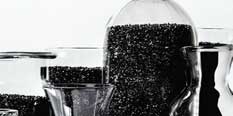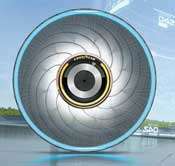Tyre companies are applying the brakes on traditional rubber tyres with innovative materials and connected technologies, says Angelica Buan in this article.
The tyre industry has been focusing on efficiency, safety and sustainability, and to achieve these is zeroing in on manufacturing practices, material sourcing and end-product designs. With the global emphasis on climate change, traditional tyres have been placed under scrutiny for their environmental impact. These include microrubbers emanating from tyre abrasion and microplastics produced from wear and tear of tyres during driving as well as greenhouse gas (GHG) emissions and energy consumption during the production process.
Sustainability and cost of raw materials used in tyres, the environmental hazards of end-of-life tyres, and improving safe driving and remote vehicle management with the advent of the connected mobility era, are just a few issues that tyre makers are devoting their R&D efforts on.
Rubber additive synthesised from plants

Replacing petroleum-based materials with ones that are derived from nature is a logical step for the tyre industry towards sustainability. With a market growth potential of nearly US$800 million within five years, according to a report by Markets and Markets, green materials such as nanocellulose are gaining traction in biobased rubber manufacturing due to their intrinsic properties, abundance and renewability. A versatile high-strength and lightweight biomaterial, nanocellulose is regarded for its relative ease of preparation in high yield, high specific surface area, and high strength and stiffness; and when used in nanocomposites, its reinforcing potential.
The application of nanocellulose as a rubber additive has been piloted by India-headquartered carbon black supplier Birla Carbon, together with Brazilian industrial biotechnology company GranBio Technologies using its BioPlus nanocellulose technology, in a breakthrough innovation in Nanocellulose Dispersion Composite (NDCTM) masterbatch for tyres.
The result of a three-year joint development programme between the two companies, the patentpending NDC masterbatch is designed to address growing sustainability demands from the tyre industry both in terms of improving tyre rolling resistance and vehicle fuel economy.
The incorporation of the bioderived nanocellulose into commercial rubber compounds provides optimal dispersion in rubber formulations to improve physical performance and increase sustainable material content, the team said.
Seemingly the missing piece to the dispersion puzzle – the challenge of effective dispersion of hydrophilic nanocellulose into hydrophobic rubber formulations – the development of NDC masterbatch is expected to increase the uptake of biobased rubber additives in the tyre sector.
Renewable materials enhance flexibility, road adhesion
Worldwide over 1.6 billion new tyres/year are produced and around 1 billion/year of waste tyres are generated, with only 10% recycled, according to a report by Goldstein Research. The complex design of tyres makes them indestructible in nature and thus problematic to recycle. On the other hand, the insoluble polymeric materials in tyres are not biodegradable and may take centuries to decompose in the environment.
Plant-based, renewable rubbers offer an environmentfriendly solution without jeopardising the safety integrity of the tyres.

Speciality chemicals company Kuraray takes this direction with a biobased liquid farnesene rubber (L-FR) that replaces petroleum-based materials. The L-FR is synthesised from beta-farnesene derived from renewable resources such as sugar cane. Adding L-FR to the compound improves the performance and lifetime of tyres. This new material, according to Kuraray, keeps the tyre’s elasticity, especially at lower temperatures and provides optimal adhesion on snowy and icy roads. Tyre manufacturers also benefit from faster cross-linking and lower viscosity, which leads to a more efficient production process.
The special structure of highly branched molecular chains reduces entanglements and results in lower viscosity compared to liquid isoprene rubbers, according to Kuraray. Due to its high molecular weight, L-FR co-crosslinks during the vulcanisation process. The “bleeding” of the low-molecular components to the outside surface, which occurs with conventional plasticisers is significantly reduced and results in permanently high elasticity and constant properties over the entire lifetime of the tyres.

Similarly, US-based Goodyear Tire & Rubber Company has utilised soybean oil in rubber compound applied to tyres. The soybean oil, according to Goodyear, helps keep the rubber compound pliable in changing temperatures, a key performance in maintaining and enhancing the vehicle’s grip on the road surface.
Goodyear’s tests have shown rubber made with soybean oil mixes more easily in the silica-reinforced compounds used in manufacturing certain tyres. This also improves manufacturing efficiency and reduces energy consumption.
The US tyre maker recently introduced the Assurance ComfortDrive, its fourth tyre to use soybean oil. Some ComfortDrive tyres also feature rice husk ash silica. Another latest offering is the reCharge Concept tyre, which Goodyear says is 100% biodegradable.
The reCharge is a concept tyre that features reloadable and biodegradable tread compound, which can be recharged with individual capsules, simplifying the process of replacing tyres.
Filled with a customised liquid compound, these capsules allow the tread to regenerate and the tyre to adapt over time to climatic circumstances, road conditions, or simply how one want to travel. Aided by artificial intelligence, a driver profile would be created around which the liquid compound would be customised, generating a compound blend tailored to each individual.
The compound itself would be made from a biological material and would be reinforced with fibres inspired by one of the toughest natural materials in the world: spider silk. This would make it both extremely durable and fully biodegradable.
